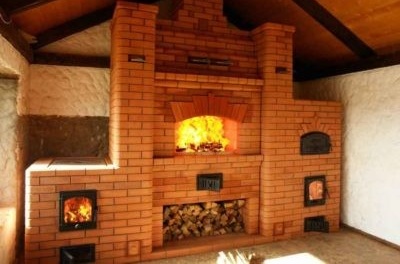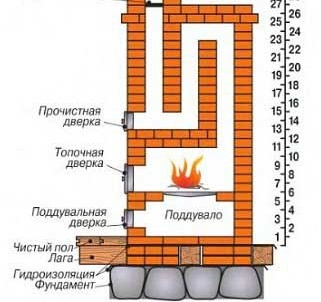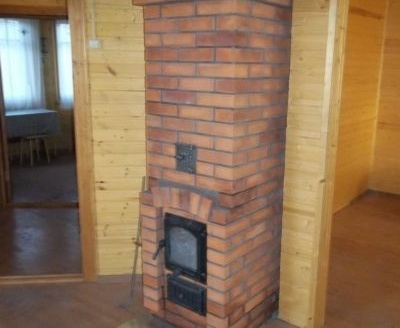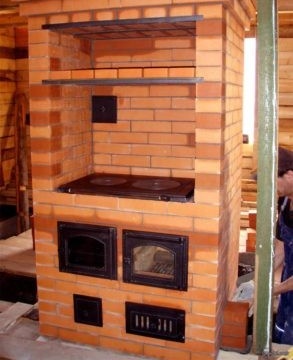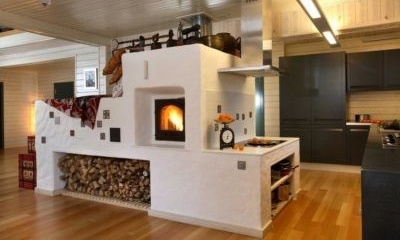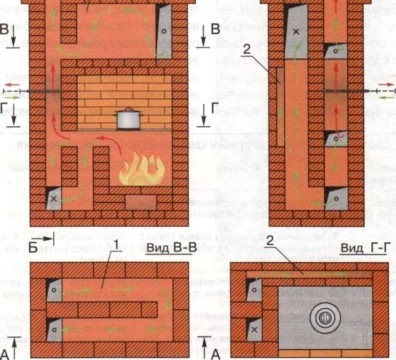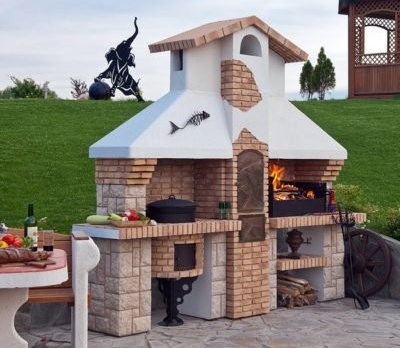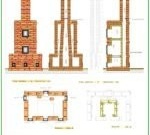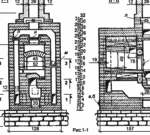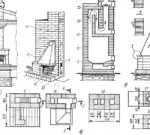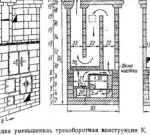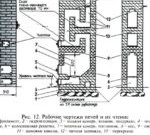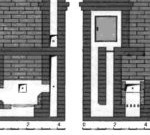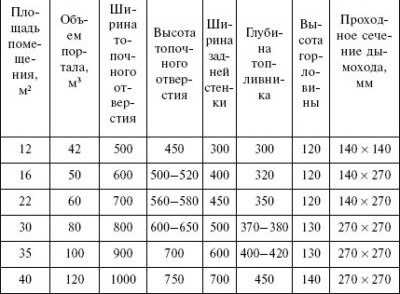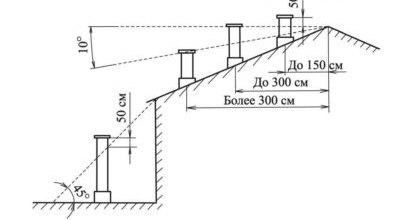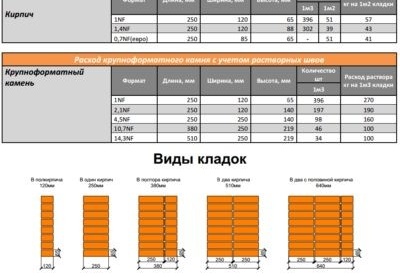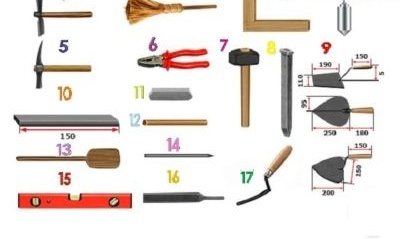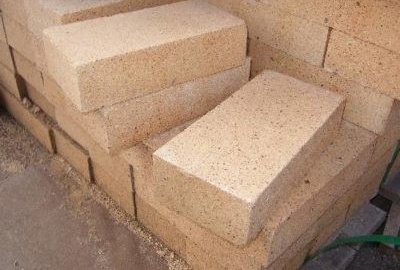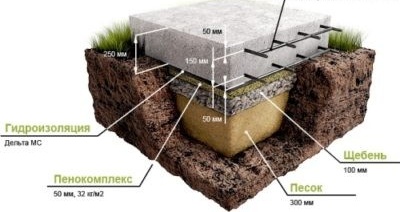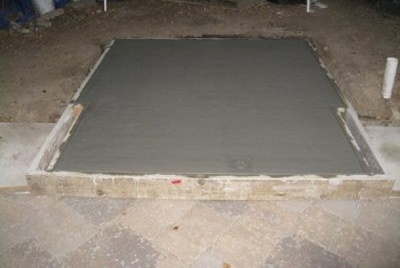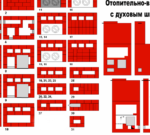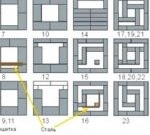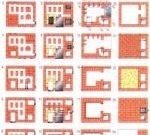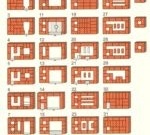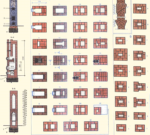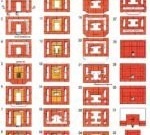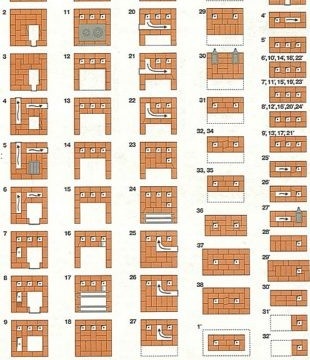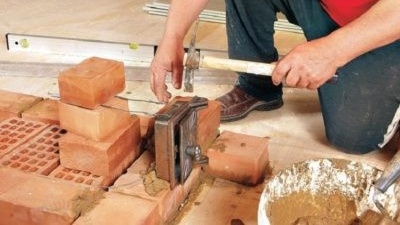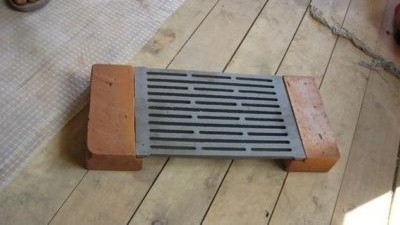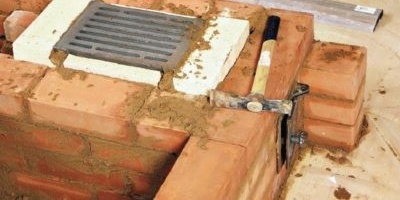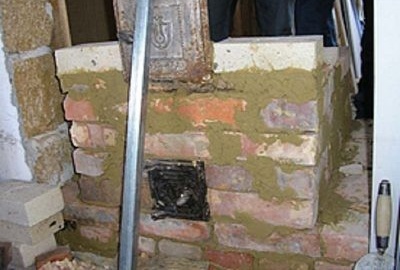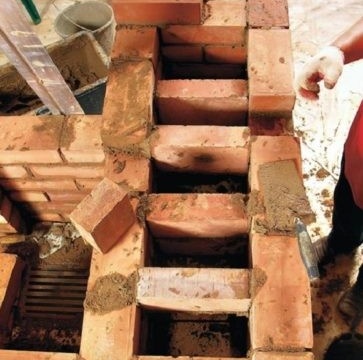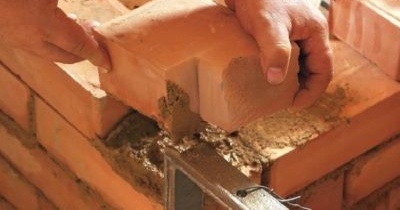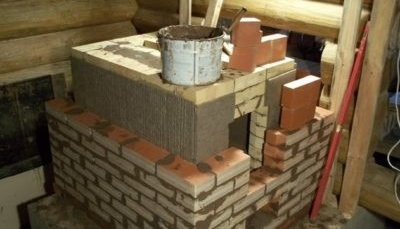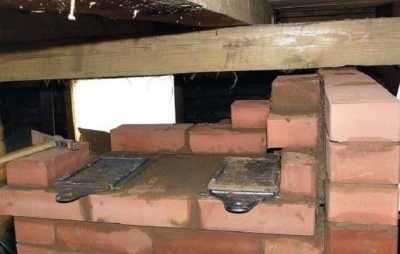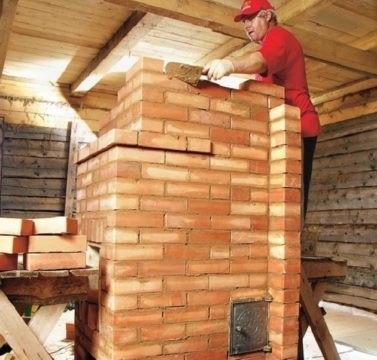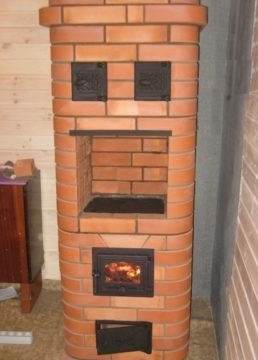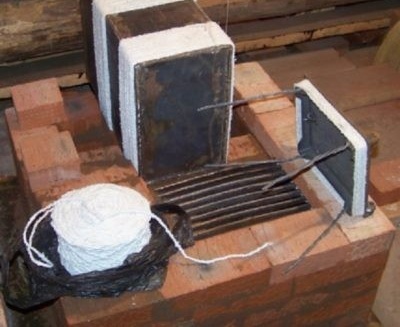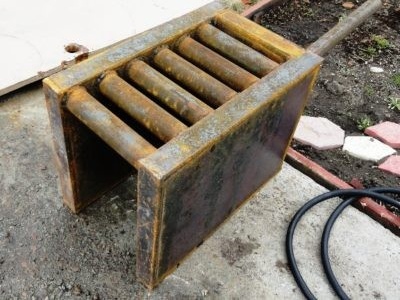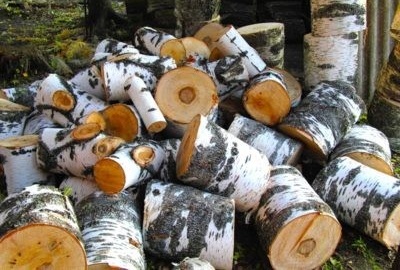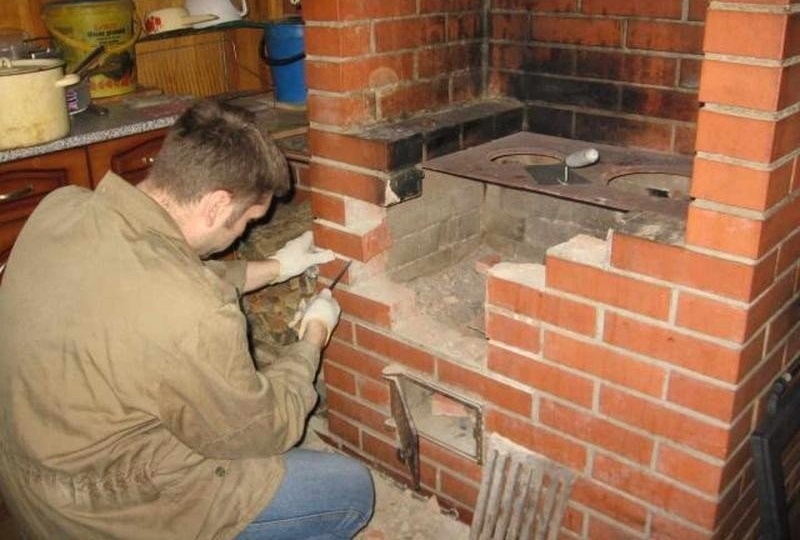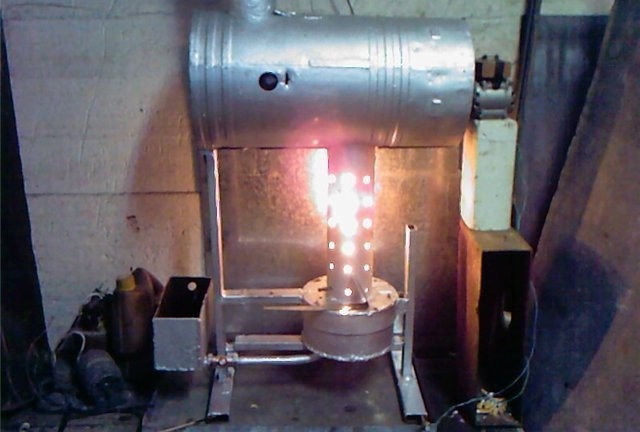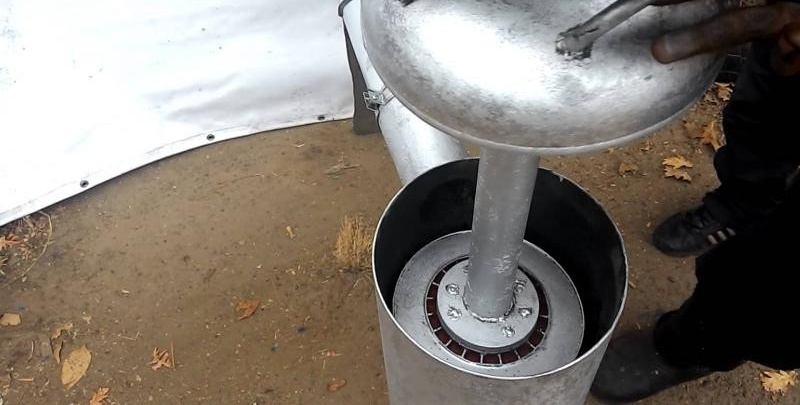DIY brick ovens: craft secrets
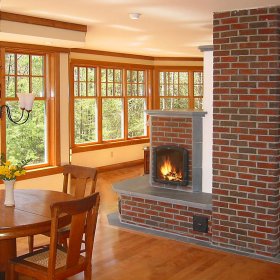
Stove heating of country houses today is gaining a second youth. And this is not surprising, given the special atmosphere and home warmth that can be created by a simple brick stove, even made by sviomi hands. Often it is installed even in the presence of more advanced heating systems, trying to get a stylish, distinctive element of the interior. Today we will talk about the most popular models of brick ovens and share the secrets of the furnace craft.
Content
Features and secrets of the popularity of brick kilns
Probably, there is no such person who would not like a live hearth with crackling firewood and especially comfortable warmth. But the good old brick stove can please not only this, but also the ability to create the most favorable atmosphere for health. It's all about the material from which this amazing unit is being built. Being the closest relative of ceramics, the brick releases water vapor into the air when heated, and when it cools, it takes them back. The stove, as it were, “breathes,” thanks to which optimal humidity is established in the room. It is also important that the heat becomes already at a temperature of 18–19 ° С, while when using other types of heating the comfort level starts from 20–21 ° С. In addition, being made of clay, the brick is an environmentally friendly material, which means that when using a heating device, you can not worry about the allocation of compounds harmful to health.
Despite the fact that each type of brick heat generators has its own functional and design features, they are all similar to each other in terms of equipping the furnace and heat exchange parts. So, any stationary furnace of this type has:
- the foundation, which serves as the basis of the heating device and evenly distributes its weight over the entire area;
- a firebox that simultaneously acts as a firebox and a combustion chamber;
- grate, allowing to realize a lower air supply to the combustion zone.Due to this, the productivity of the heating unit increases and it becomes possible to adjust the intensity of fuel combustion;
- an ash chamber, which facilitates the cleaning of the furnace;
- a chimney that creates the necessary draft and emits exhaust gases into the atmosphere.
In addition to its main purpose, wood heat generators are also used for cooking, as well as arranging an additional resting place. The structure itself can be installed both indoors and in the yard, for example, in a recreation area with a barbecue, barbecue or cauldron. If we talk about fireplace stoves, then their heat-generating function is completely relegated to the background, giving way to a visual and image component.
The advantages of brick kilns include:
- fast heating of the surface;
- the possibility of using several types of fuel;
- low operating costs;
- eliminates the risk of burns when touching the walls of the heater;
- especially soft, comfortable warmth;
- the air in the room is not dehydrated;
- ample opportunities in terms of decorating the interior.
The units under consideration also have disadvantages. The most significant of them is the potential danger of carbon monoxide poisoning, which occurs during improper use. One more - large dimensions and weight. That’s probably all. As you can see, this type of equipment has continuous advantages and an almost complete absence of negative aspects, which, however, determines its high popularity.
Classification of heating appliances. Criteria for choosing the optimal design
All existing models of brick kilns can be divided into several types:
- heating appliances;
- cooking units;
- combined furnaces;
Having decided on the required functionality, it is necessary to choose the option that can be folded independently. In order not to consider the whole variety of stationary units, we dwell on the most popular options:
- Dutch ovens. Thanks to the channel design, they have good heat dissipation and take up little space. Such heat generators operate in the mode of slow burning or decay, which significantly reduces the quality requirements for building materials. And although the efficiency of the Dutch women rarely exceeds 40%, they found a lot of fans, partly due to the low cost and ease of construction.
- Swedish wood-burning stoves have a chamber-channel layout, which allows you to increase the efficiency up to 50%. Just like the Dutch women, the Swedes take up little space, but require a more careful approach to the choice of materials and are a bit more difficult to manufacture. Nevertheless, labor and finance costs are fully justified by the increased productivity and expanded functionality of this type of heat generators.
- Russian stoves have a unique layout, so they carry an indescribable flavor and identity. Their efficiency exceeds 60%, but not everyone will like the features of operation. In addition, not every beginner will be able to lay down the stove. Most likely, you will have to hire a professional stove-maker, and this will entail additional costs, which will increase the cost of the not-so-cheap design.
- Kuznetsov bell-type furnaces, famous for their thermal efficiency, have an efficiency of up to 90%. The secret of their success lies in a special device that contributes to the most complete combustion of fuel and maximum heat transfer. A feature of the “blacksmiths” is the extremely clean “exhaust” and the absence of soot, which minimizes the time required to take care of the heater.As for the minuses, then they include the complexity of the design and high requirements for materials. However, the last drawback is compensated by the fact that the brick for the construction of the "caps" will require significantly less than for any other furnace.
You will find step-by-step instructions for laying the Kuznetsov furnace with orders in our next article:http://aquatech.tomathouse.com/en/otoplenie/pech-kuznecova-poshagovaya-instrukciya-po-izgotovleniyu.html.
Having considered all the possible options, we came to the most crucial moment - the choice of a heating device that can satisfy all the requirements for it. The main criteria in this case are functionality and installation location. And if the first does not present difficulties, since it completely depends on the preferences and requirements of the owner, then the second paragraph requires the closest attention. We will tell you more about how to choose a furnace in accordance with the type of structure.
- House designed for permanent residence. If stove heating will be used as the main one, then there is no better option than a "Swedish" or a "hood". In addition to the fact that these units have excellent performance and do not take up much space, they are also easily supplemented with other elements - a hob, water circuit, oven, drying niches or a stove bench. If functionality is relegated to the background, and the main requirement is compactness, then a “Dutch” is a good option, heating several adjacent rooms.
- Country house "weekend" or cottage. Since these buildings require irregular living, it will be enough to install a small heating device equipped with a hob. Ideal options are open hearth fireplaces, since they can be used to heat a room in the shortest possible time. Such an advantage cannot be overestimated in winter, when the air temperature in the room drops to subzero temperatures.
- A stove in a country house with water or other type of heating. In this case, the heater serves to create a special atmosphere. If the area allows, you can install a full-fledged Russian stove or unit with a firebox, fireplace and stove bench.
- The heater for the bath. For this case, the simplest stove-heater is suitable, in which a tank is built to produce hot water. If the bathhouse is attached to the house, then instead of the tank, you can install a full-fledged boiler, designed for a liquid heating system.
- Outdoor ovens. Most often, such heaters are installed on open verandas, in summer kitchens or gazebos and are used for cooking. For this purpose, the design is additionally equipped with a hob, barbecue, barbecue, cauldron, etc.
Having decided on the type and filling of the furnace, do not rush to begin construction. In order for the heater to be able to live up to all expectations, it is necessary to thoroughly understand the principles of its operation.
Calculation of the main parameters
Before choosing a working draft of a heating device, it is necessary to make a preliminary calculation according to the parameters of a particular room. The most accurate method is to determine the size based on the heat transfer of the furnace. In order not to go into complicated calculations, for well-insulated houses they use a simplified calculation scheme proposed by I.V. Kuznetsov. This method uses an average thermal power taken from one square meter of the surface of the unit (TMEP). For a conventional firebox, a value of 0.5 kW / sq. m, and if necessary, intense heating, which occurs during severe cooling, up to 0.76 kW / sq.m
When determining the thermal power of a furnace, only those surfaces that are involved in heat transfer processes are taken into account. For example, in the Dutch women, wall sections located at the floor below the horizontal sections of the gas duct are not excluded from calculations.
In principle, already these values are enough to select a suitable project from those that can be found in the public domain. If the available options for some reason do not fit, then you will need to calculate the parameters of the main elements of the furnace and design your own design.
Drawings and schemes of brick ovens
- The furnace for a bath
- Russian stove
- Fireplace stove
- Swedish oven
- Classic Dutch
- Bell furnace
Firebox
The dimensions of the furnace are determined based on the maximum volume of the fuel bookmark. The amount of combustible materials is calculated using their calorific value and specific gravity, focusing on the required power. The volume of the firebox should be 2-3 times greater than the obtained value, which will allow the furnace to overheat at extremely low temperatures.
When calculating the size of the furnace part, it must be taken into account that the maximum tab should not exceed 2/3 of the volume of the combustion chamber. In addition, the dimensions of the furnace and all its components must be adjusted to the size of the bricks used for laying the furnace. In your calculations, you can use special tables developed taking into account the need for heating rooms of various quadratures.
Ashpit
The height of the ash pan depends on the type of fuel used. For low-ash combustible materials such as coal or peat briquettes, this value is taken equal to 1/3 of the height of the firebox. If the furnace is heated with wood or pellets, then the height of the ash chamber must be reduced to 1/5.
Chimney
Unlike gas heating equipment, wood stoves do not require much traction, so a rectangle will be the best shape of the smoke channel. When calculating the chimney, it is taken into account that the cross section of the blower should not exceed the area of its gas duct, while all values are adjusted to the dimensions of a standard brick. Since accurate design requires operating with a wealth of data and parameters, it is best to use one of the special programs. Nevertheless, for the most common cases (absence of kinks in the smoke channel, vertical stroke, rectangular cross-section, height from 4 to 12 m), you can use the average values for furnaces up to 14 kW:
- Less than 3.5 kW - 140x140 mm.
- 5 - 5.2 kW - 140x200 mm.
- From 5.2 to 7.2 kW - 140x270 mm.
- From 7.2 to 10.5 kW - 200x200 kW.
- 5 - 14 kW - 200x270 mm.
Recommended sizes are minimum. And yet there is no need to excessively increase the cross section of the chimney, since cold air will fall into the stove through an overly wide chimney. The counterflow, or “whistle-blower” in the language of professional stove-makers, threatens not only with a deterioration in productivity, but also with more serious problems.
It is best to use special tables to calculate the amount of material needed. Below is one of them.
You should not worry if the designed “offhand” chimney occasionally starts to smoke. If necessary, it can be built up with a piece of asbestos-cement pipe 0.5–1 m long or several more rows of bricks can be laid. Often, such events are carried out with the changing aerodynamics of the area. For example, after the growth of trees or the construction of higher buildings in the neighborhood.
Preparatory Activities
Preparation for construction includes several stages:
- selection of tools and necessary materials;
- determination of the optimal location for the installation of the heater;
- arrangement of the foundation and preparation of the construction site;
- making kiln bricks (if necessary) and preparing masonry mortar.
Necessary materials and tools
For laying a brick oven you will need:
- Mason's hammer (with a striker and a pick).
- Broom for squeezing rows.
- Corner, plumb and level to control the geometric parameters of the masonry.
- Pliers.
- Rubber mallet (mallet).
- Trowel (trowel).
- Rule and ramming for arrangement of the foundation.
- Scriber lead.
- Spatula or mixer for mixing the solution.
- Stitching.
- Buckets and other containers for bulk solids and liquids.
- Sieve.
- Grinder (angle grinder) with a circle on the stone.
Despite the fact that brick stoves differ significantly in design and size, the list of materials that will be needed for construction remains virtually unchanged. A standard list of everything you need looks like this:
- Brick - red, silicate, refractory and facing (depending on the design of the solid fuel heat generator).
- Mortar for masonry furnaces. If necessary, cheaper construction can be replaced by clay and sand.
- Furnace casting set - blower, furnace and cleaning doors, gate valves, stove, oven, etc.
- Grate.
- Wire for fixing cast iron.
- Asbestos or basalt cord.
- Steel strips and corners for arranging floors and niches.
- Heat-resistant boards for protective thermal insulation.
Any brick kiln is an aggregate with an impressive weight, which requires a capital base. Therefore, it is necessary to prepare materials for the construction of the foundation:
- Sand.
- Rubble.
- The grid is reinforcing.
- Boards and nails for the construction of formwork.
- Cement.
- Waterproofing.
In addition, if the project provides for external wall decoration, then prepare the tools and materials that will be needed for these works.
Features of choosing a place for installing a heater
Most often, a brick oven is installed near one of the walls or in the corner of the room - this will make it possible to use the available area in the most rational way. If the unit is planned to be used for heating several rooms, then it is located in the center of the house, orienting the furnace and hob into the kitchen, and with other faces - into the bedroom, hall or living room. The diagram clearly shows what advantages the correct choice of place gives.
When installing the heater, one should not be guided by convenience alone. It is important not to forget about the minimum allowable distances to other surfaces, as well as the optimal gaps and distances, which are determined by the current SNiP:
- From a brick chimney to wooden floor or roof elements, at least 130 mm of free space should remain. If non-insulated ceramic or steel pipe is used, then the gap is increased to 250 mm;
- between the wooden floor and the outer walls of the furnace leave a gap of at least 100 mm;
- the distance from the heated side surface of the heat generator to the combustible wall of the building depends on whether thermal insulation will be used. With a protective screen, the minimum clearance is 130 mm, and without it - at least 380 mm;
- a clearance of at least 0.35 m should be left from the ceiling to the ceiling of the furnace. When installing compact units with a low heat capacity, this distance can be increased to 0.7–1 m.
Experienced stove makers do not recommend placing the stove near the external walls of the building, arguing that it is quick cooling.
Foundation construction
It is best if the base of the brick kiln is formed at the same time as the common building foundation.In this case, both structures are performed separately, otherwise the subsidence of the walls of the building will inevitably lead to a violation of the geometry, or even damage to the heating device. If the furnace will be built in a finished house, then the first thing you pay attention to is the remoteness of the chimney from the elements of the roof overlap, which should be at least 15 cm. And only after that they begin to mark and build the foundation.
If the house has wooden floors, then at the installation site of the furnace they are cut out, departing from the external contour of 10-15 cm. After that, they dig a pit, the depth of which depends on the characteristics of the soil and the depth of its freezing. For the middle strip, it is enough to dig a hole 0.7–0.8 m deep. After that, its bottom is covered with a 15-cm layer of sand and compacted, periodically spilling with water. Then a layer of crushed stone 10–15 cm thick is poured, which is also carefully packed. After that, wooden pegs are clogged at the corners of the structure, to which the battens are fastened. To prevent the leakage of cement milk through the cracks of the mold, its walls are covered with a plastic film. At a distance of 5-10 cm from the floor, a reinforcing mesh is installed, for which both metal rods hammered into the bottom of the pit and fragments of brick are used.
Mixing cement M-400, sand and gravel in a ratio of 1: 3: 4, prepare concrete. Water is added just enough to get a medium yield solution, otherwise the strength of the structure will be reduced. The mixture is poured into the formwork and compacted in any way, after which the surface of the foundation is leveled using the rule. Note that the upper level of the base of the furnace should be 15–20 cm below the floor. After a few hours, necessary for the preliminary setting of the mortar, the structure is covered with a film and left for several weeks until completely dry.
Before laying brick, the foundation is necessarily waterproofed with roofing material or a special film. If the material is not wide enough, then its strips are laid with an overlap of at least 10 cm.
Solution preparation
Now that you can find ready-made building mixtures for laying fireplaces and stoves in the distribution network, there are practically no problems with the preparation of working mortar. All that is required is to mix the components with water using a wooden spatula or a construction mixer. Nevertheless, it is possible to make a masonry mortar on your own - this will save additional money. In addition, the owner will have full confidence in the environmental friendliness of the structure.
With your own hands you can make a building mixture from sand and clay, the ratio of which depends on the fat content of the last component. To select the optimal composition, conduct a small experiment, mixing bulk materials in different proportions. After that, balls 5–6 cm in diameter are rolled from the solution, which, after preliminary drying, is squeezed between two planks. The best composition is the one in which the sample begins to crack no earlier than it will be deformed by one third.
Another way to determine the correct ratio of components is to dip a spatula into the prepared mixture. The buildup of a solution of less than 1 mm indicates its low ductility - you need to add clay. If the thickness of the layer is more than 2 mm, then this indicates the fat content of the mixture, which can be corrected by adding sand. Norm - from 1 to 2 mm.
Clay before use must be soaked in water for a day. If you want to increase its fat content, then use the method of extrusion, which consists in upholding the clay solution and removing its middle part.
How to fold a brick stove. Instructions for the progress of work
Deciding on the type of heater, making preliminary calculations and preparing everything for the start of construction is only half the battle. In order to fold the oven correctly, it is necessary to find brick layouts in each row, the so-called orders. We have prepared some of the most popular options that can be used as work projects. If for some reason they do not suit you, you can search for ready-made solutions on the Web or order an individual layout on one of the special sites.
Schemes of the order of furnaces in the photo
- Swedish kiln arrangements
- Dutch orders
- Order of the Russian stove
- Furnaces
- Bath Furnace Arrangements
- The arrangements of the bell furnace Kuznetsov
Today we propose folding a compact, but very productive and functional brick kiln. Despite the apparent complexity, even a beginner can build it, if he uses our instructions and will fulfill all the recommendations. We, in turn, will share the secrets of experienced stove-makers and give the necessary recommendations on the progress of construction.
In the presented ordering scheme, you can see the heating unit equipped with a convenient cooking stove and a drying niche, which gives a certain resemblance to a classic Swedish stove. We recommend that you first lay the structure dry without using mortar. This will allow you to study in detail the features of each row and prepare the necessary elements of the structure. Next, the work is done in this order:
- To the floor level, bricks are laid out on a continuous cement-sand mortar. At this stage, one should be especially attentive to geometric accuracy, controlling the masonry by level and plumb. The careful implementation of the work determines how smooth and stable the oven will be.
- The first row of the furnace body begins to form a blow chamber.
- Before starting the laying of the second row, install the blower door. For this purpose, steel wire is inserted into specially cast ears on its body, which is laid in masonry seams. To prevent the door from shifting and tipping over, it is temporarily propped up with bricks.
- In the fourth row, two channels are removed for cleaning the furnace of soot. Each of them has a separate door.
- In the fifth row set the grate. Corrugations made in the bricks of the lower row will help to correctly lay the iron casting. Hereinafter, the combustion chamber is laid out exclusively with refractory bricks.
- Before laying the sixth row, a furnace door is installed, which is temporarily fixed with a stack of bricks laid on the grate. If necessary, the part from the outside is propped up with a metal corner or wooden lath.
- Starting from the seventh row, they begin to equip the gas ducts of the furnace. The vertical walls of the furnace are laid out with fireclay bricks installed on the edge.
To ensure the durability of the structure, the external masonry is separated from the combustion chamber by a layer of basalt cardboard.
- Before starting the laying of the ninth row, a quarter is selected in the bricks that will block the furnace door. Thanks to this, the design will look even and aesthetically pleasing. Here, the cast iron part is finally fixed, laying the wire in the seam of the ninth row.
- In the 11th row, a hob is placed on the upper opening of the fuel chamber. As a seal, the same basalt cardboard or asbestos cord is used.The front of the cooking niche is framed by a steel corner.
- From the 12th to the 16th row, a chamber is built over a cast-iron stove.
- Before overlapping the cooking niche, steel strips are laid on its side walls, which will serve as a support for the 17th row bricks. The front of this row is decorated with a metal corner.
- The 18th and 19th row are laid out almost completely, only three vertical heat exchangers are being built up.
- In the 20th row, a horizontal channel and a door are arranged for cleaning soot and soot, and they also begin to form a drying chamber.
- The masonry of the 22nd row block the door.
- On the 23rd row, they overlap the horizontal gas duct. Only the openings of the vertical channels are left open.
- Before laying the 24th row, steel strips are placed above the drying chamber.
- From the 25th to the 28th row, another cleaning door is installed and the furnace niche is closed.
- In the 30th row, valves are installed on the two remaining vertical ducts. To do this, first mount their frames, and then insert the partitions themselves.
- From the 31st to the 35th row, lay out the transitional section of the chimney.
- From the 36th to the 38th row, they build a fluff.
On this, the laying of the furnace body can be considered completed. The remaining orders will help to lay down the chimney:
- Starting from the 1st row, they begin to spread the riser. In our case, it ends with the 26th row, but if necessary, the length of the pipe can be increased in accordance with the height of the building.
When constructing chimney ducts, special attention is paid to the internal cleanliness of their walls. It must be remembered that the smoother their surface, the less soot will remain on them.
- In the third row of the chimney, another door is installed to clean the chimney.
- On the 27th row, a central shutter is installed.
- In the 31st row, the section of the masonry is reduced in order to bring the pipe through the roof.
In the place where the chimney passes through the ceiling, it is isolated from overlapping by non-combustible materials. For this, both mineral insulation and expanded clay are used. He is poured into a box, which is knocked around a chimney.
Briefly about the installation of the oven and heat transfer register
Previously, we examined how to mount and fasten oven doors. It is equally important to correctly establish other functional elements.
If the oven is designed for the oven, it is installed so that a stream of heated gases bathes the largest possible surface area. Most often, these conditions correspond to the section of the transition from the furnace to the heat exchanger. Previously, metal corners are laid on the side walls of the horizontal flue, and the places of contact of the cabinet with the outer wall of the furnace are sealed with basalt cardboard or an asbestos cord.
A water heating boiler or liquid heat transfer register is installed in the hottest zone of the furnace. Depending on the type of heat generator, this place may be located at the rear of the combustion chamber, at the beginning of the gas duct or under the hood of non-rotating units. If you plan to use a cooktop and a water heater at the same time, then its upper part is made in the form of transversely arranged metal pipes, which are welded into the side tanks of furnace steel. A compensation gap of 5-15 mm is left between the boiler and the walls of the furnace. Of course, it is necessary to provide how the surface of the heat exchanger will be cleaned of soot. For canal and chamber furnaces this can be done through the firebox opening, while in other cases it may be necessary to install an additional cleaning door.
You may also find it useful to know which materials are best used for facing a brick kiln:https://aquatech.tomathouse.com/en/otoplenie/otdelka-pechi-v-dome-svoimi-rukami.html.
Features of operation and cleaning of the furnace
Immediately you can’t test the furnace at maximum conditions, you must wait for its walls to dry. That is why it is recommended to erect a heating device in the warm season. During this period, it is enough to open all the openings of the brick unit and wait one to two weeks. If there is a need to dry the stove in cold weather, then its doors are closed, and in the combustion chamber include a fan heater or a powerful incandescent lamp.
After the specified period, the stove is heated 2-3 times a day for 5-7 days, each time using a small amount of firewood. The complete drying of the walls is indicated by the absence of condensation on metal surfaces, which appears a few minutes after kindling. And even after that the furnace is not heated “to the fullest”. Operation at maximum power is checked only after several days of regular use.
If the unit is heated exclusively by firewood, then it is not necessary to clean it from ash each time. In the case of using peat briquettes and coal, the furnace is freed from ash and ash at the beginning of each new cycle. As for cleaning the internal channels and the chimney from soot, this procedure is carried out at least once a season. For this purpose, use various scrapers and brushes that remove carbon deposits from vertical surfaces. After that, the soot is scooped out of the flues with a metal scoop and poker.
The right choice of fuel will help reduce soot formation. Hardwood is considered to be the best firewood - oak, hornbeam, beech, etc. Almost no birch firewood and aspen leave soot. By the way, experienced stove-makers recommend that every tenth furnace be carried out with aspen logs, claiming that this helps to remove soot from the channels and the chimney.
It is not recommended to clean the stove by burning with the use of flammable liquids, smoke powder (yes, you can find such “useful” tips), naphthalene, etc. A good effect can hardly be achieved, but nearby buildings and your own health can cause significant damage.
Often it is difficult to kindle the furnace after a long cooling period, for example, in a cottage or in a country house. This is due to the fact that cold air descends into the channels of the furnace, forming hard-to-remove gas plugs. A proven method will help resume traction. To do this, take dry paper or rags moistened with kerosene or barbecue liquid, lay it closer to the vertical duct and set fire. Intense combustion instantly pushes stagnant air masses and restores the heater.
You will also need material with instructions for cleaning and minor repairs of brick kilns:https://aquatech.tomathouse.com/en/otoplenie/kak-pochistit-pech.html.
Video: Compact brick oven original design
A brick oven can create a warm atmosphere in the room, will become a highlight of the interior and a gathering place for friends and acquaintances. It is not only experienced craftsmen who can put the unit together, but also green beginners. Of course, one must be scrupulous and as attentive as possible. And then the heater will repay not only cozy warmth and comfort, but also safe operation for many years of operation.
